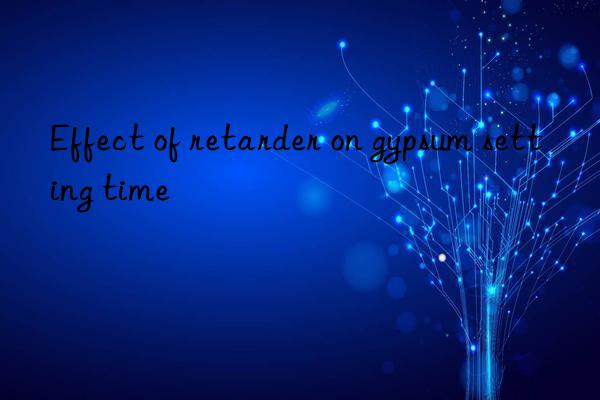
Since the setting time of commonly used beta semi-hydrated gypsum powder is too short to meet the construction requirements of painting and painting, retarder is often added to extend or adjust the setting time of the painting material. Commonly used retarders include: organic acids and their salts (such as citric acid, sodium citrate, tartaric acid, potassium sodium tartrate, etc.), phosphates and borate, denatured proteins, sucrose, etc. When choosing a retarder, comprehensive considerations must be taken into consideration. coagulation effect, raw material cost and impact on other properties. We selected several retarders and studied their effects on the initial setting and final setting of beta stucco gypsum slurry. From the above experimental results, we can see that citric acid and SC retarder have better retarding effects. Citric acid The retarding effect of salt is second. When the addition amount is the same, the retarding effect of tartaric acid and its salts is obviously worse than that of citric acid and SC; the retarding effect of sucrose is worse than that of citric acid, tartaric acid and SC; the retarding effect of phosphate The coagulation effect is the worst. The same retarder has different retarding effects on β-semihydrate gypsum powder from different manufacturers from different origins at the same amount. In our experiments, we selected multiple β-gypsum powder products and all had this problem. This may be closely related to the raw materials from different origins, the production processes of different manufacturers (such as calcination temperature, raw material particle size), storage and transportation, etc. This phenomenon has been confirmed in the studies of many scholars [5]. It was also found in the experiment that the more retarder is added, the better. Taking citric acid as an example, as the amount of citric acid added increases, the setting time of the gypsum slurry becomes longer, its strength loss also increases, and the production cost also increases. When no water-retaining agent is added, a large amount of water leaks out from the surface of the sample. Therefore, on the premise of meeting the construction requirements, on the one hand, an appropriate amount of retardant must be added, and on the other hand, a certain amount of appropriate water retaining agent must be added to ensure that the hydration reaction is fully completed. In addition, adding other mixed materials can also play a reinforcing role.
Influence of the strength properties of gypsum plastered with clinkers such as slag and cement
While adding slag, some additives can also be added appropriately to improve its activity. It is not difficult to see that lime increases the strength of stucco gypsum relatively little, and slag does not increase material strength much without adding cement clinker. The addition of slag can also improve the workability of plaster gypsum, making it easier to operate during construction. However, it should be noted that the above-mentioned materials should not be added in too much amount. This is because these materials are highly alkaline, resulting in a high pH of the stucco plaster, which will cause the organic polymer film coated on it to turn yellow. Go bad. This may need to be adjusted depending on the specific application.
2.3 Effect of water-retaining agent on the performance of stucco gypsum
In order to meet the needs of practical applications, stucco gypsum adds a certain retarder. As mentioned above, retarder It is easier to cause the gypsum hydration reaction to slow down, and a certain amount of water will seep out from the surface of the gypsum slurry. This water will evaporate, which will seriously affect the complete progress of the hydration reaction, thereby affecting the strength of the material.
The retention rates of the three types of preservatives are: MC is greater than CMC and is greater than bentonite. Compared with inorganic water-retaining agents, organic water-retaining agents not only have good water retention effects, but also can improve the flexural strength of stucco gypsum. Experiments have found that, Organic water-retaining agents can also improve the adhesion of plaster to walls. In addition, MC and CMC can also improve the surface gloss of stucco plaster. However, the raw material cost of the three types of water-retaining agents is that bentonite is smaller than CMC and CM. Therefore, in practice, we should choose the water retention rate according to the specific situation, and can also mix and match them.
Conclusion: From the above experimental results and discussion, the following conclusions can be drawn:
(1) The retarding effect of common retarder. Citric acid > citrate > tartaric acid > tartrate > sucrose > phosphate, SC also has a better retarding effect. The same retarder may have different retarding effects on β-hemihydrate gypsum powder from different origins when used in the same amount.
(2) As inorganic admixtures, slag and cement can improve the strength of stucco gypsum. (3) Water retention effects of three types of water retention agents. MC is larger than CMC than sodium bentonite.
(4) In actual production, according to the specific situation, the formula should be reasonably designed to not only meet the actual index requirements, but also reduce the production cost as much as possible to facilitate the promotion and application of the product. </p

 微信扫一扫打赏
微信扫一扫打赏

